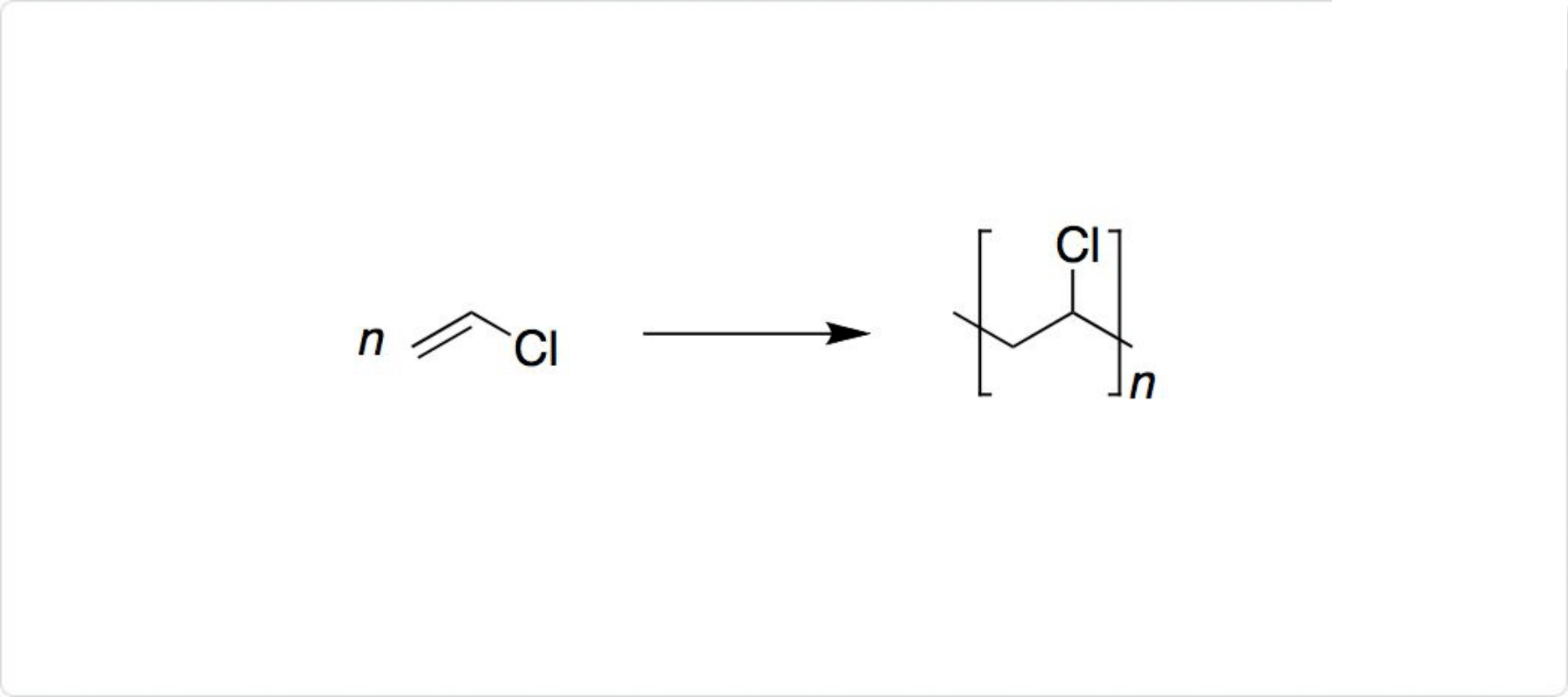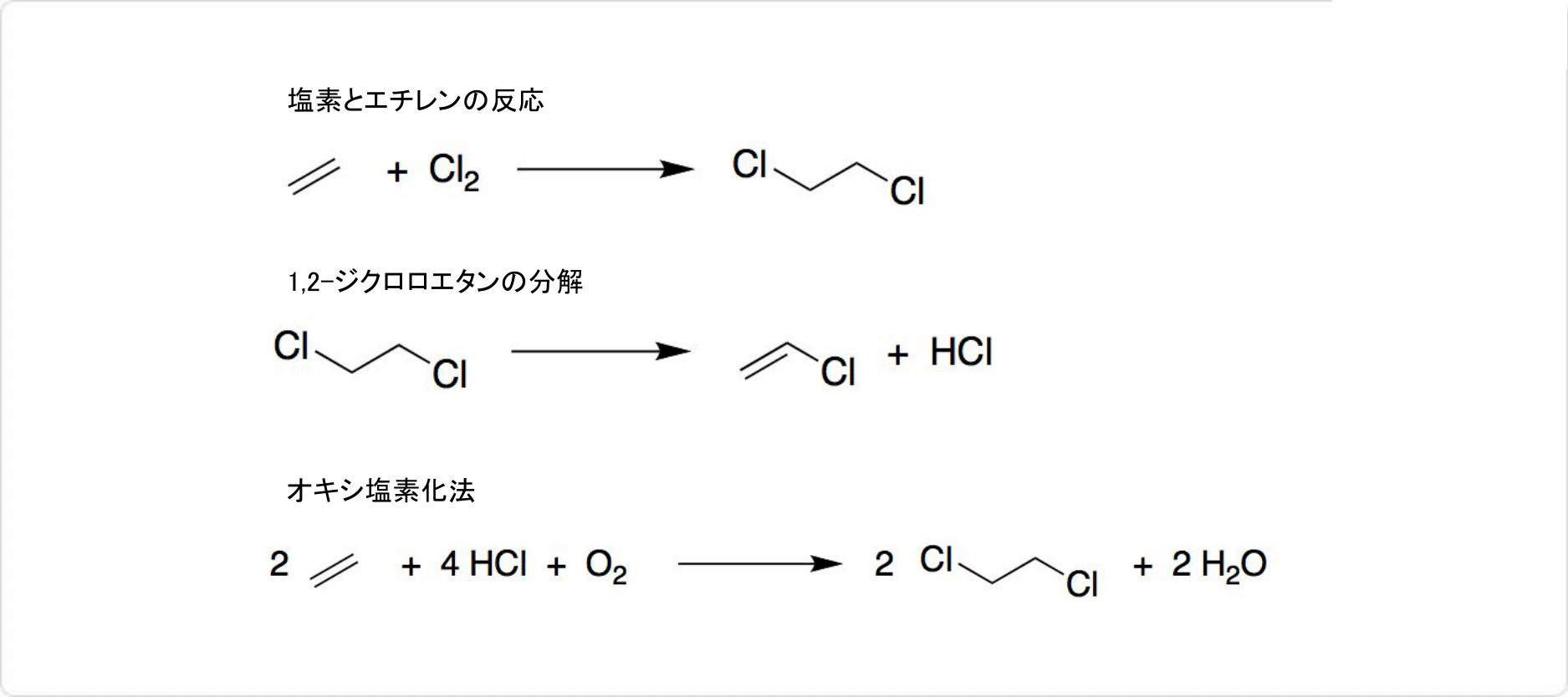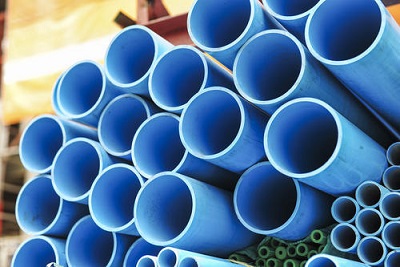塩化ビニル 化学特性,用途語,生産方法
外観
白色の粒状
定義
本品は、塩化ビニルの重合体であり、次の化学式で表される。
性質
塩化ビニル樹脂は,耐水,耐酸,耐アルカリ性,電気絶縁性にすぐれ,難燃性である.しかし,熱,光に比較的抵抗性を欠き,脱塩酸して着色する.したがって,一般に可塑剤,安定剤,充填剤などの補助材料を加え成形加工される.可塑剤の混入度によって軟質,硬質に分けられる.フィルム,レザー,電線被覆,シート,繊維,パイプなどで広く利用されているほか,酢酸ビニル,塩化ビニリデン,アクリル酸エステル,アクリロニトリルなどの共重合体としての用途も多い.[[別用語参照]硬質ポリ(塩化ビニル),ポリ(塩化ビニル)
溶解性
シクロヘキサノン, テトラヒドロフラン及びニトロベンゼンなどに可溶。溶媒はシクロヘキサノン、テトラヒドロフラン、ニトロベンゼンなどにかぎられるが、低分子量のものはメチルエチルケトン、ジオキサンなどにも溶ける。
解説
略称PVC樹脂.一般式 で表される塩化ビニルの重合体.現在,工業的には主として塩化ビニルの懸濁重合でつくられている.すなわち,耐圧反応容器内に少量の分散剤(おもにポリ(ビニルアルコール)),重合開始剤を含む水中に塩化ビニルモノマーを加え,はげしくかくはん,分散懸濁させて重合反応を行わせる.反応終了後,懸濁スラリーからPVC粒子を分離,乾燥させると粒径約100~150 μm のPVC粒状粉末が得られる.乳化重合は古くからヨーロッパで行われてきたが,現在では特殊用途のいわゆるペースト樹脂の生産に採用されている.水の使用量を減らして懸濁重合のコストを下げる試みとして,塊状重合も一部では行われている.PVC粉末は白色で,密度1.2~1.6 g cm-3.nD1.54.ガラス転移点70~80 ℃,約150~200 ℃ で融解する.塩化ビニル樹脂は,耐水,耐酸,耐アルカリ性,電気絶縁性にすぐれ,難燃性である.しかし,熱,光に比較的抵抗性を欠き,脱塩酸して着色する.したがって,一般に可塑剤,安定剤,充填剤などの補助材料を加え成形加工される.可塑剤の混入度によって軟質,硬質に分けられる.フィルム,レザー,電線被覆,シート,繊維,パイプなどで広く利用されているほか,酢酸ビニル,塩化ビニリデン,アクリル酸エステル,アクリロニトリルなどの共重合体としての用途も多い.[CAS 9002-86-2][別用語参照]硬質ポリ(塩化ビニル),ポリ(塩化ビニル)
で表される塩化ビニルの重合体.現在,工業的には主として塩化ビニルの懸濁重合でつくられている.すなわち,耐圧反応容器内に少量の分散剤(おもにポリ(ビニルアルコール)),重合開始剤を含む水中に塩化ビニルモノマーを加え,はげしくかくはん,分散懸濁させて重合反応を行わせる.反応終了後,懸濁スラリーからPVC粒子を分離,乾燥させると粒径約100~150 μm のPVC粒状粉末が得られる.乳化重合は古くからヨーロッパで行われてきたが,現在では特殊用途のいわゆるペースト樹脂の生産に採用されている.水の使用量を減らして懸濁重合のコストを下げる試みとして,塊状重合も一部では行われている.PVC粉末は白色で,密度1.2~1.6 g cm-3.nD1.54.ガラス転移点70~80 ℃,約150~200 ℃ で融解する.塩化ビニル樹脂は,耐水,耐酸,耐アルカリ性,電気絶縁性にすぐれ,難燃性である.しかし,熱,光に比較的抵抗性を欠き,脱塩酸して着色する.したがって,一般に可塑剤,安定剤,充填剤などの補助材料を加え成形加工される.可塑剤の混入度によって軟質,硬質に分けられる.フィルム,レザー,電線被覆,シート,繊維,パイプなどで広く利用されているほか,酢酸ビニル,塩化ビニリデン,アクリル酸エステル,アクリロニトリルなどの共重合体としての用途も多い.[CAS 9002-86-2][別用語参照]硬質ポリ(塩化ビニル),ポリ(塩化ビニル)
森北出版「化学辞典(第2版)
用途
少量の安定剤、着色剤を加え、単独重合体から硬質のパイプ、板、継手、繊維など。大量の可塑剤と少量の安定剤、着色剤を混和した軟質製品にはカレンダー加工によるフィルム、シート、織物被覆があり、ふろしき、レインコート、カーテン、農業用、ハンドバッグ生地、座席カバー、旅行カバンが代表的用途である。押出加工によるチューブは水道、ガスホースに、電線被覆したものには特にビニル電線とよばれている。ビニルタイルはカレンダーまたは押出加工によりつくられている。
用途
フィルム?シート、レザー、電線被覆、硬質管、一般塗料ベース、船底塗料ベース、紙のつや出し、接着剤、防湿セロファン、衣料用、カーペット、漁網、ろ布 (化学工業日報社)
構造

図. ポリ塩化ビニルの合成
塩化ビニルはビニル基と塩素を持っており、示性式はCH2=CHClで示されます。モル質量は62.5です。塩化ビニルの単量体は、炭素原子が二重結合を有しています。
塩化ビニルが付加重合すると、となります。なお、ポリ塩化ビニルの示性式は、[-CH2-CHCl-]nです。
化粧品の成分用途
皮膜形成剤
合成法

図. 塩化ビニルの合成
直接塩素化法によって、塩化ビニルを合成できます。まず、触媒に塩化鉄 (III) を用いて、塩素とエチレンを反応させることで、1,2-ジクロロエタン (英: 1,2-Dichloroethane) が生成します。反応に使用するエチレンはナフサの熱分解によって、塩素は塩化ナトリウムの電気分解によって、それぞれ得ることが可能です。
次に、1,2-ジクロロエタンを500℃で加熱し、15〜30気圧で圧縮します。1,2-ジクロロエタンは分解し、塩化水素とともに、塩化ビニルを生成可能です。工業的生産では、オキシ塩素化法が用いられます。副生成物として生じた塩化水素を空気と混合して、触媒に塩化銅 (II) を使ってエチレンと反応させると、1,2-ジクロロエタンが生成します。
直接塩素化法とオキシ塩素化法を併用すると、反応プロセス全体で副生成物が発生しません。したがって、環境負荷を抑えられます。
主な用途/役割
塩化ビニルを重合させて得られる樹脂。ビニルフィルム用、ヒートシール用接着剤原料として使用される。
説明
Polyvinyl chloride, commonly abbreviated PVC, is the thirdmost widely produced plastic, after polyethylene and polypropylene. PVC is used in construction because it is more effective than traditional materials such as copper, iron or wood in pipe and profile applications. It can be made softer and more flexible by the addition of plasticizers, the most widely used being phthalates. In this form, it is also used in clothing and upholstery, electrical cable insulation, inflatable products and many applications in which it replaces rubber.

Pure polyvinyl chloride is a white, brittle solid. It is insoluble in alcohol, but slightly soluble in tetrahydrofuran.
化学的特性
Peroxide- or thiadiazole-cured CPE exhibits good thermal
stability up to 150°C and is much more oil resistant than
nonpolar elastomers such as natural rubber or EPDFM.
Commercial products are soft when the chlorine content is
28–38%. At more than 45% chlorine content, the material
resembles polyvinyl chloride. Higher-molecular-weight
polyethylene yields a chlorinated polyethylene that has
both high viscosity and tensile strength.
物理的性質
PVC is a thermoplastic polymer. Its properties for PVC are usually categorized based on rigid and flexible PVCs.
Mechanical propertiesPVC has high hardness and mechanical properties. The mechanical properties enhance with the molecular weight increasing, but decrease with the temperature increasing. The mechanical properties of rigid PVC (uPVC) is very good, the elastic modulus can reach to 1500-3,000 MPa. The soft PVC (Flexible PVC) elastic is 1.5- 15 MPa. However, elongation at break is up to 200% -450%. PVC friction is ordinary, the static friction factor is 0.4-0.5, the dynamic friction factor is 0.23.
Thermal propertiesThe heat stability of PVC is very poor, when the temperature reaches 140 °C PVC starts to decompose. Its melting temperature is 160 °C. The linear expansion coefficient of the PVC is small and has flame retardancy, the oxidation index is up to 45 or more. Therefore, the addition of a heat stabilizer during the process is necessary in order to ensure the product's properties.
Electrical propertiesPVC is a polymer with good insulation properties but because of its higher polar nature the electrical insulating property is inferior to non polar polymers such as poly ethylene and poly propylene.
使用
Polyvinyl Chloride could be useful for the removal epoxidation catalyst from epoxidized unsaturated oils.
調製方法
In chlorinating polyethylene, chlorine atoms substitute for
hydrogen atoms of the polyethylene chain in both crystalline
and amorphous regions. The most common chlorination
method is treating polyethylene powder in an aqueous
suspension that contains hydrochloric acid and a free-radical
initiator with chlorine gas. After the desired level of
chlorination is obtained, the CPE is water washed and dried,
and an antiblocking agent is then added.
定義
ChEBI: A polymer composed of repeating chloroethyl units.
一般的な説明
Poly(vinyl chloride) [PVC] is a polymer which is mostly prepared from vinyl chloride monomer. In most cases PVC is mixed with heat stabilizers, lubricants, plasticizers, fillers, and other additives.
危険性
Decomposes at 148C, evolving toxic fumes
of hydrogen chloride. Pneumoconiosis, lower respi-
ratory tract irritant, and pulmonary function effects.
Questionable carcinogen.
使用用途
塩化ビニルはポリ塩化ビニルとして、身の周りで広く使われています。ポリ塩化ビニルとは、塩化ビニルの重合体です。主な用途として、塩化ビニルパイプが挙げられます。
塩化ビニルパイプは、機械的安定性、耐久性、耐クリープ性、接着性に優れています。また、樹脂製品であるにも関わらず、難燃性であることも特徴です。非常に安定した物性のため、上下水道管のほか、工業資材や、車や家電、医療機器など、幅広い分野で用いられています。
さらに、財布やソファに用いられている合成皮革やレインコートなどでは、軟質のポリ塩化ビニルが材料となっています。
類似物
ポリ塩化ビニルの合成
塩化ビニルの重合反応によって、高分子化合物であるポリ塩化ビニルを得ることが可能です。ポリ塩化ビニルは、塩化ビニール、ビニール、塩ビなどと呼ばれます。
ポリ塩化ビニルを原料の塩化ビニルと区別するため、単量体の塩化ビニルは塩化ビニルモノマー (英: vinyl chloride monomer) と呼ばれています。
参考文献
使用用途
ポリ塩化ビニルは安価で加工性が高い上、添加剤を変えることで様々な性質を発現するため、幅広い用途に使用されています。ポリ塩化ビニルは硬質ポリ塩化ビニルと軟質ポリ塩化ビニルに大別され、それぞれ用途が異なります。
1. 硬質ポリ塩化ビニル
硬質ポリ塩化ビニルは、可塑剤含量が10%以下のものです。主な用途として、看板や標識、上下水道管のパイプや継手、腐食性ガスや薬品用配管材料、電線配線用管などが挙げられます。
2. 軟質ポリ塩化ビニル
軟質ポリ塩化ビニルは、可塑剤が25~50%含まれるものです。主にシート状 (0.2mm厚以上) 、フィルム状 (0.2mm厚以下) 、レザー (裏生地付) 、押出加工されたものがあります。それぞれの用途としては以下の通りです。
- シート状:ハンドバック、ベルト類、スリッパ、クッションフロアー、浮袋
- フィルム状:レインコート、長靴、使い捨て手袋、かさ、食品などの包装、農業用フィルム、衣料
- レザー:車両内装材、家具、カバン用、衣料用
- 押出加工:繊維、電線被覆、軟質ガス管、ガーデンホース
工業用途
Among the vinyl polymers and copolymers, the polyvinyl chloride (PVC) thermoplastics are the most commercially significant. With various plasticizers, fillers, stabilizers, lubricants, and impact modifiers, PVC is compounded to be flexible or rigid, opaque or transparent, to have high or low modulus, or to have any of a wide spectrum of properties or processing characteristics.
PVC resin can also be chlorinated (CPVC) and it can be alloyed with other polymers such as ABS (acrylonitrile butadiene styrene), acrylic, polyurethane, and nitrile rubber to improve impact resistance, tear strength, resilience, heat-deflection temperature, or processibility.
PVC is a hard, flame-resistant, and chemicalresistant thermoplastic resin. The resin is available in the powder form, as a latex, or in the form of plastisol. PVC resin, pigments, and stabilizers are milled into plasticizers to form a viscous coating material (plastisol) that polymerizes into a tough elastic film when heated. Plastisols are used extensively for coating glass bottles and glass fabrics. The dispersion types of resins are used in flexible molding compounds. Such formulations consist of a vinyl paste resin, a suitable plasticizer such as dioctyl phthalate, and a stabilizer (usually a compound of lead). Flexible molds are widely applied to plaster casting and encapsulation of electronic circuits with epoxy resins.
安全性プロファイル
Chronic inhalation of
dusts can cause pulmonary damage, blood
effects, abnormal liver function. “Meat
wrapper’s asthma” has resulted from the
cutting of PVC films with a hot knife. Can
cause allergic dermatitis. Questionable
carcinogen with experimental tumorigenic
data. Reacts violently with F2. When heated
to decomposition it emits toxic fumes of
Cland phosgene.
概要
ポリ塩化ビニルとは、「塩ビ」や「PVC (polyvinyl chloride) 」とも呼ばれる合成樹脂の一つです。
可塑剤などの添加剤を加えることで、様々な性質を発現できます。そのため、硬質プラスチックや軟質プラスチック、ゴムなど多種多様な製品の原料として使われています。
特徴
ポリ塩化ビニルの特徴を (PE) や (PP) 、 (PS) など、他の汎用的なプラスチックと比較して紹介します。
1. 長所
- 炭素-塩素結合を有しており、化学的安定性に優れている。また、難燃性や耐久性にも優れている。
- 他の樹脂に比べて結晶性が低く、炭素-塩素結合という極性基を含有するため、様々な物質と混和しやすく、多種多様な添加剤、改質剤を加えることで種々の機能を発現できる。
- 酸や塩基への耐性が高く、ほとんどの無機薬品への耐性も高い。有機溶媒については、などの芳香環を有する溶媒やなどのケトン類、などの環状エーテルには溶解するが、これら以外の薬品に対する耐性は比較的高い。
2. 短所
- ポリエチレンなどの樹脂に比べると耐衝撃性に劣る。特に低温下では脆く、割れやすくなる。ただし、可塑剤を添加すれば耐衝撃性を上げることは可能。
- 軟質ポリ塩化ビニル製品を長期間使用すると、内部の添加剤が表面に滲み出したり揮発したりすることがある。
製造方法
ポリ塩化ビニルは塩化ビニルモノマーの重合により作られますが、工業的な製造方法としては、懸濁重合、沈殿重合、乳化重合が挙げられます。
懸濁重合
塩化ビニルモノマー、重合開始剤、水を混合し、加圧重合槽内で加熱重合させます。反応後、ポリ塩化ビニル樹脂が水中に分散したスラリーが得られるので、残存モノマーを除去した後、脱水・乾燥することで粉末状のポリ塩化ビニル粉末が得られます。
沈殿重合
塩化ビニルモノマーを溶解し、ポリ塩化ビニルは溶解しない溶剤中で重合を行う方法です。塩化ビニルモノマーと開始剤と溶剤を混合し低温で重合させると、ポリ塩化ビニルが析出してきます。この混合物をフィルターろ過することで、低重合度のポリ塩化ビニルの粉末が得られます。
乳化重合
塩化ビニルモノマー、界面活性剤、水、水溶性の開始剤を混合し重合させる方法です。モノマーは水中で乳化され、乳化液滴内で重合します。重合後のポリマーを回収するために、塩や酸の添加で界面活性剤の乳化分散効果をなくし、凝集させ、その後、脱水・乾燥することでポリ塩化ビニル粉末が得られます。
塩化ビニル 上流と下流の製品情報
原材料
準備製品